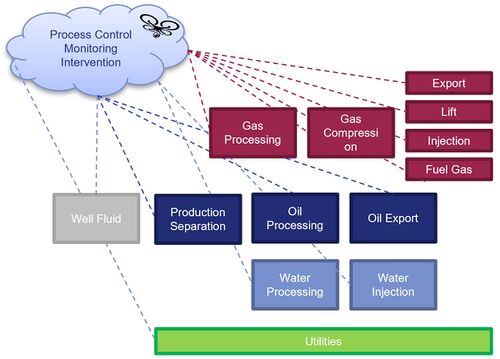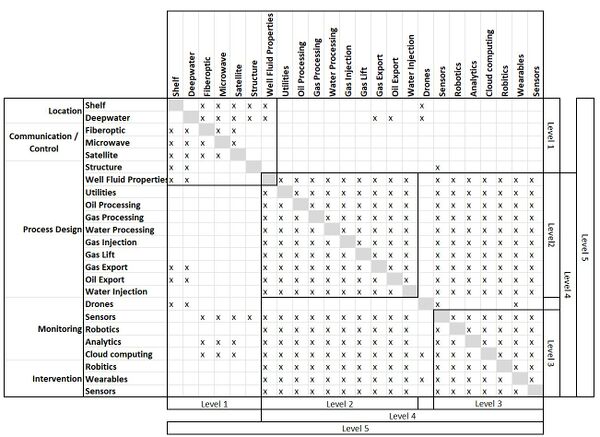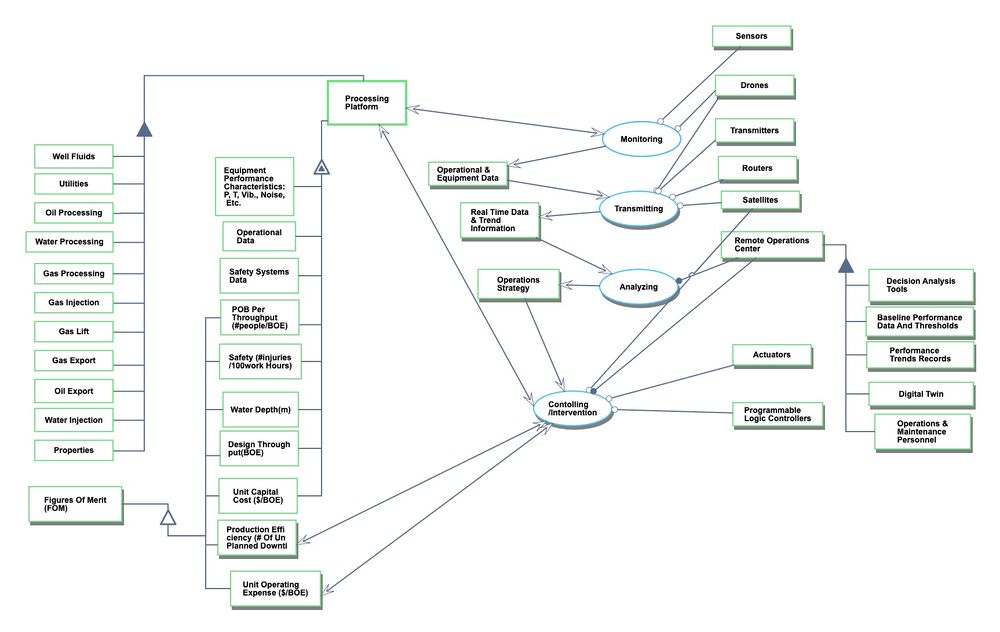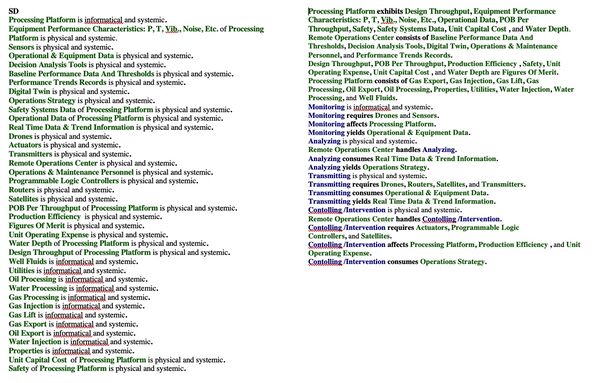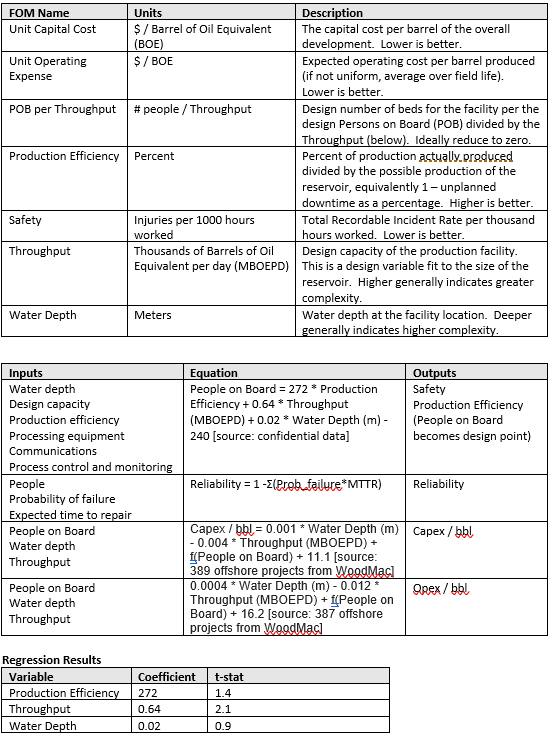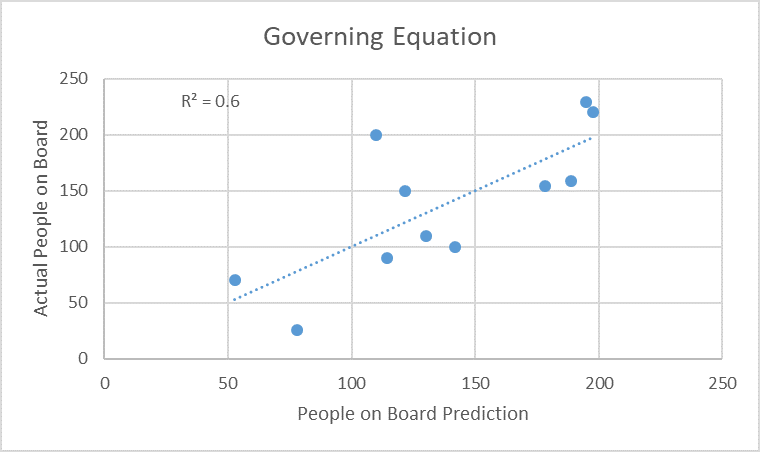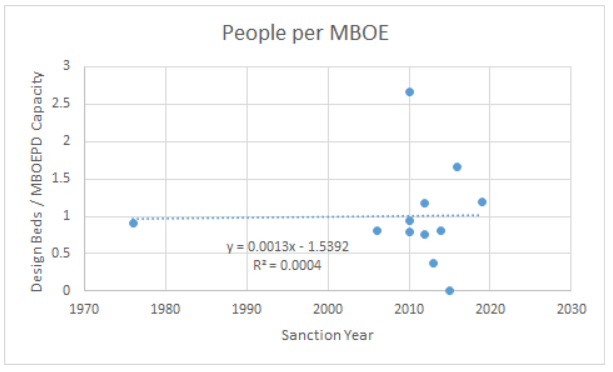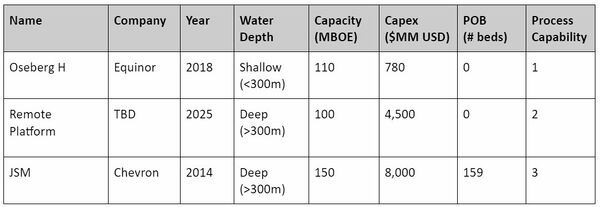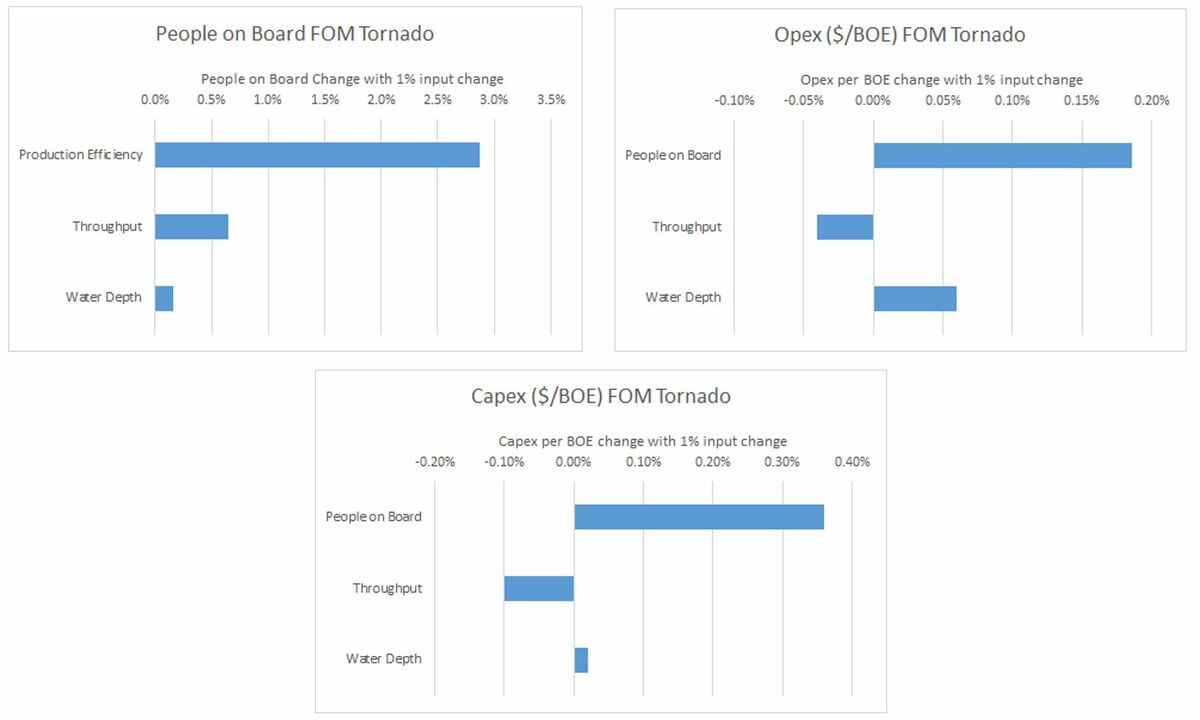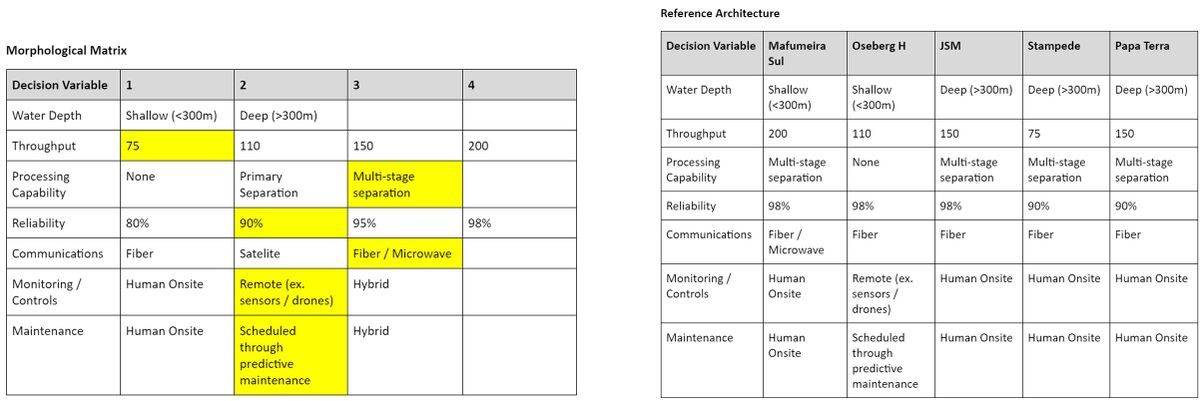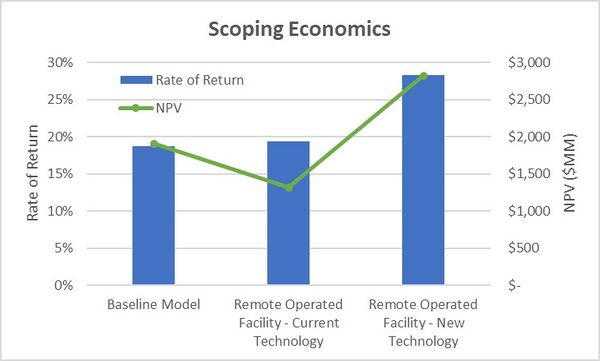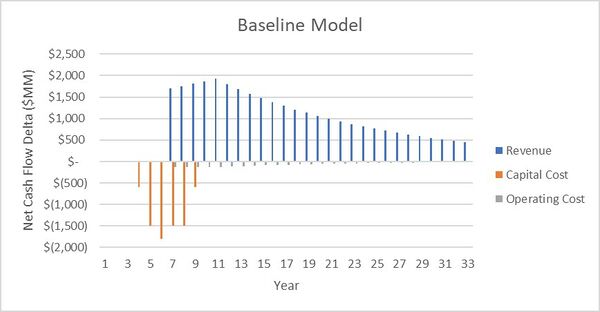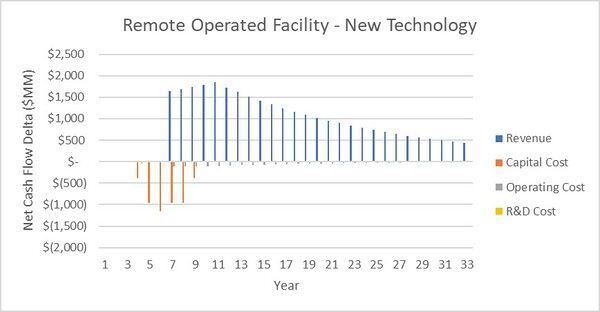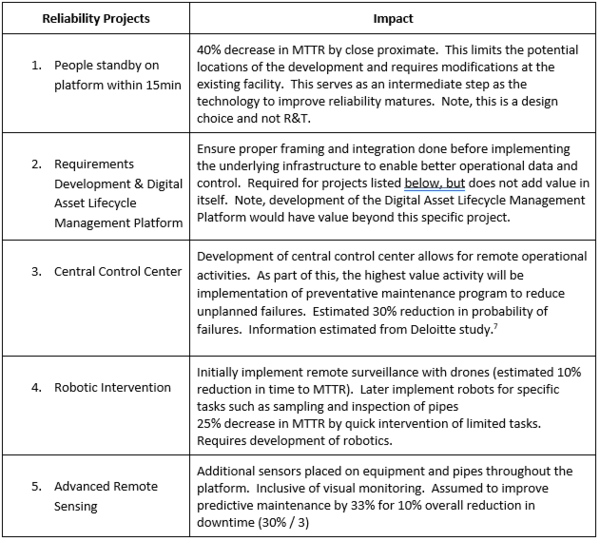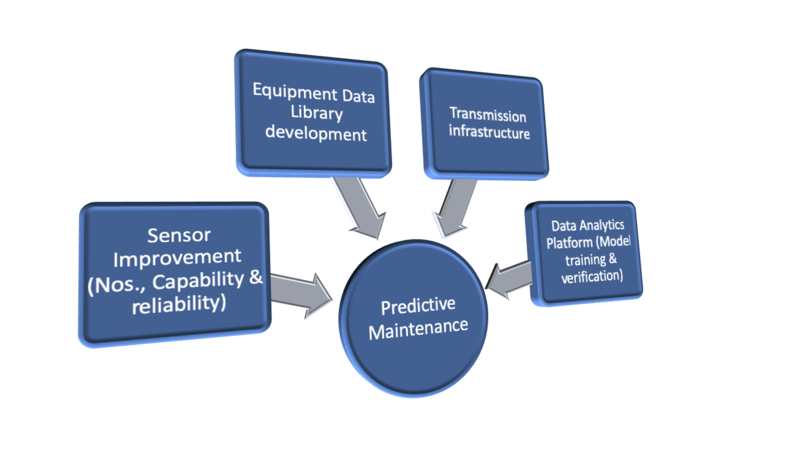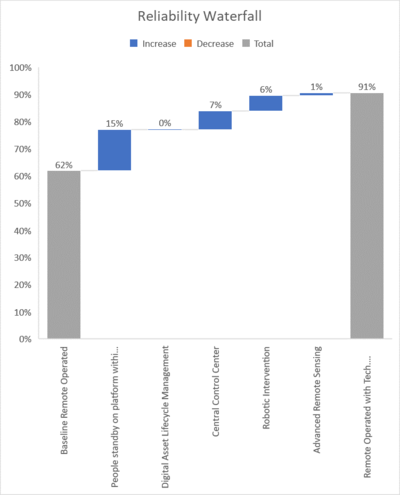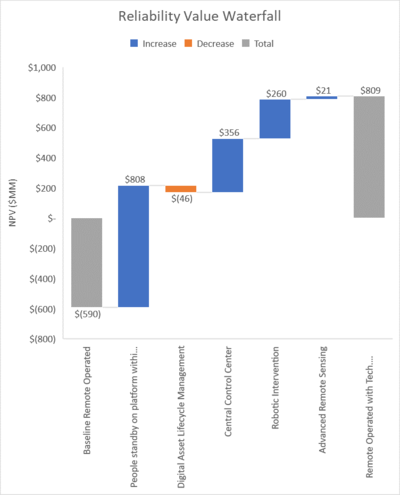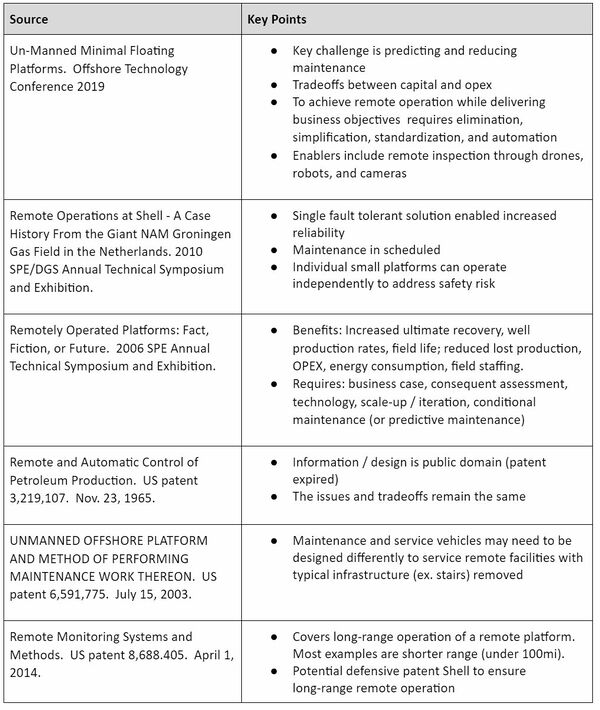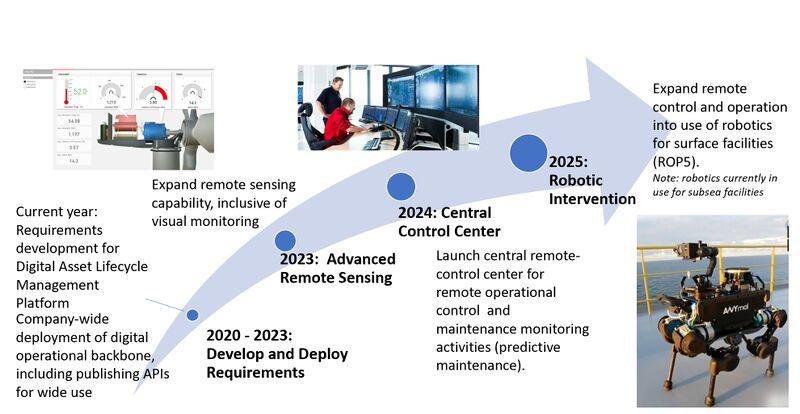Difference between revisions of "Remote Operated Processing Platform"
| (142 intermediate revisions by 5 users not shown) | |||
| Line 1: | Line 1: | ||
=Technology Roadmap Sections and Deliverables= | =Technology Roadmap Sections and Deliverables= | ||
On an offshore oil and gas platform, operators are physically located on the facility to provide local intervention with a goal of ensuring safe, reliable processing capabilities. Introduction of a remote operated platform removes operations and maintenance personnel from being physically located on the platform to a central operating location where the focus is on real-time monitoring and intervention is achieved. It is worth noting that this is primary a systems integration and scale-up issue. The vast majority of the underlying technology has been proven across different applications, but never integrated into a new large deepwater development. <br> | |||
<br> | |||
The unique identifier outlined in the roadmap is that of a remote operated oil and gas processing platform, level 5 - '''ROPP5''' | |||
==Roadmap Overview== | ==Roadmap Overview== | ||
The working principle and architecture of a remote operated oil and gas processing platform is depicted in the below. | The high-level working principle and architecture of a remote operated oil and gas processing platform is depicted in the below. The core infrastructure of any offshore oil and gas processing facility consists of an inlet well fluid stream and initial separation followed by oil, water, and gas processing streams. Utilities support all processing streams and include main power, instrument air, heating and cooling medium, fresh and seawater supply to name a few. | ||
[[File:RdmpOverview.jpg|frameless]] | [[File:RdmpOverview.jpg|500px|frameless]] | ||
As of today, these processes are more or less controlled via central control room on a production facility with manual intervention by operations and maintenance personnel, as required. The elimination of onsite personnel is depicted in our overview to highlight a remote control center operated via cloud computing technology. | |||
==Design Structure Matrix (DSM) Allocation== | ==Design Structure Matrix (DSM) Allocation== | ||
We can extract from the DSM below that the remote operated processing platform is composed of and dependent on a series of decisions and technologies. These decisions and subsequent technologies include facility location, communication and control method, process design, monitoring and intervention. | |||
[[File:UpdateRODSM.jpg|600px|frameless|Remote Operated Platform DSM]] | |||
Level 1: Communication and structural design, dependent on reservoir location - Platform design: '''PD1''' <br> | |||
Level 2: Facility design, dependent on well fluid characteristics - Facility design: '''FD2''' <br> | |||
Level 3: Independent, remote monitoring - Remote monitoring design: '''RMD3''' <br> | |||
Level 4: Monitoring, dependent on facility operating design - Operating design: '''SOD4''' <br> | |||
Level 5: Remote operated platform, dependent on location, well fluid characteristics, and monitoring - Remote Operated Processing Platform: '''ROPP5''' | |||
==Roadmap Model using OPM== | ==Roadmap Model using OPM== | ||
We provide an Object-Process-Diagram (OPD) of the | We provide an Object-Process-Diagram (OPD) of the in the figure below. This diagram captures the main object of the roadmap (oil platform), its various processes required for transferring of information to control the facility remotely, as well as the Figures of Merit and main processes. | ||
An Object-Process-Language (OPL) description of the roadmap scope is auto-generated and | [[File:OPD Unmanned Rev1.jpg|1000px|frameless]] | ||
An Object-Process-Language (OPL) description of the roadmap scope is auto-generated via Opcloud and provided below. This is simply an export of the OPD in a formal natural language. | |||
[[File:OPL Rev 3.jpg|600px|frameless]] | |||
==Figures of Merit== | ==Figures of Merit== | ||
[[File: | The table below show a list of FOMs by which a remote operated processing platform can be assessed. The best indicator of the profitability of any oil and gas development is the unit cost, which is the capital required to produce the barrels of oil in the development and the unit operating expense. This is a strong function of the People on Board, but the information is highly confidential and cannot be shared publicly. It is shown as f(People on Board) in the equations to maintain confidentiality. Any sustaining technology will need to be competitive within the capital and operating cost per barrel before other considerations. The main consideration outside of cost is safety and environment. Focusing on safety as measured through injuries per 1000 hrs worked, the simplest way to reduce the safety incidents is to remove the people. Removing people is the focus of this technology. Our measure is Design People on Board (POB) per throughput to normalized for the size of the development. When plotted with historical data we see a clear trend with throughput as shown in the governing equation regression below. The other main factor in determining the people is the complexity of the development. Two measure of complexity include water depth (deeper is more complex operating environment) and production efficiency (higher production efficiency is more difficult and requires more resources). | ||
Below we have a summary of the figures of merit, governing equation as derived by the relationships noted above, and a graph of the predicted values from the governing equation vs. the actual results. | |||
[[File:FOM rev4.png|1000px|frameless]] | |||
[[File:POBpred.png|1000px|frameless]] | |||
[[File: | When we look at the the changes in time for people vs. capacity, we do not see not see any trend. This measure has not been a key consideration in the past, and we would consider it a disruptive technology as it changes the focus of figures of merit. | ||
[[File:PeoplevCapacity.png|1000px|frameless]] | |||
==Alignment with Company Strategic Drivers== | ==Alignment with Company Strategic Drivers== | ||
The table below outlines potential strategic drivers and statements of alignment of remote operated platforms with the company targets. These targets are all inline with both Company and joint industry forecasts. | |||
[[File:Stratdriver2.jpg|600px|frameless]] | |||
==Positioning of Company vs. Competition== | ==Positioning of Company vs. Competition== | ||
The process capability listed in the competition table is illustrative of either 1-no separation (process fluid transportation), 2-stage (liquid/gas) or 3-stage oil/water/gas. As illustrated in the competition landscape, there is one known unmanned wellhead platform that is operated remotely from a central facility and many offshore processing platforms in operation. | |||
[[File:Compe.jpg|600px|frameless]] | |||
Note that there are many examples (excluded from table, included in Pareto Front) with 3-stage process capability at various capacities and POB values. This table was compiled to show an estimate of a future installation of a simple processing platform with 2-stage separation operated remotely. | |||
==Technical Model== | |||
The | The approach was to focus on the value drivers of the capital and operating cost per barrel as predictable and measurable outcomes. The safety benefits are much harder to realize without very in-depth models of risk factors. The methodology identified that there are key environmental attributes accounted for in the water depth and throughput as well as the reliability component. The People on Board is a proxy for the operating and maintenance staff which keep the production online. From a cost component, there is infrastructure and ongoing operating expense to support. Sensitivities were calculated through individual and multiple-regression of projects with the key parameters. The reference offshore facility of 75 MBOEPD and 100 people was then used to assess the percentage impact of a one percent change in each key variable. An average variation was used to calculate the sensitivity using the sample data. Note, in all cases the coefficients demonstrate significant uncertainty (t scores typically between 1 and 2). In the design People on Board, we were able to use actual data. For the Opex and Capex sensitivities, we need to use a combination of sources. External data available through WoodMac was utilized to identify cost sensitivity to water depth and throughput. Proprietary studies were used to estimate the sensitivity to design people on board. These studies included model forecasts of capital and operating cost changes with change in People on Board. Simple ratios with the capacity could be used to get the impact of People on Board to capital and operating cost per barrel. While we believe the results are representative, we do note that there is significant uncertainty. <br><br> | ||
== | '''Equations''' <br> | ||
People on Board = 272 * Production Efficiency + 0.64 * Throughput (MBOEPD) + 0.02 * Water Depth (m) - 240 [source: 11 real projects, confidential data] <br> | |||
Opex per Barrel = 0.001 * Water Depth (m) - 0.004 * Throughput (MBOEPD) + f(People on Board) + 11.1 [source: 389 offshore projects from WoodMac] <br> | |||
Capex per Barrel = 0.0004 * Water Depth (m) - 0.012 * Throughput (MBOEPD) + f(People on Board) + 16.2 [source: 387 offshore projects from WoodMac] <br> | |||
Note: sensitivity of Opex and Capex per barrel to People on Board coefficient and data confidential and withheld. <br><br> | |||
'''Key Points''' <br> | |||
The key insight is that the People on Board FOM is most sensitive to production efficiency which is a proxy for reliability. This intuitively makes sense as the people are on the platform to ensure that operations are stable and continuous. It also highlights that by designing to a higher reliability, one can tradeoff the number of people on the platform. This dovetails to Capex / bbl and Opex / bbl metrics. The hypothesis is that there is a tradeoff between Capex, Opex, and people. Interestingly enough, reducing the design People on Board reduces both Capex and Opex. The intuition is that it avoids capital expenditure such as living quarters and other systems designed specifically for people. Having less people means a lot less associated expenses which is logical. This brings up the interesting point that if it reduces capex and opex per barrel, then why have there been no discernible changes is People on Board over time? The answer is not clear at this time but might be related to the increased technical complexity of developments over time (easier developments are no longer available) and the technical challenges with increasing reliability / decreasing people. Of note, it is also possible that the relationship is not linear and while completely removing people is highly economic, it might take incremental steps that have marginal economics. | |||
[[File:FOMtornados.jpg|1200px|frameless]]<br><br> | |||
<br> | |||
[[File:ROPmorphmat2.jpg|1200px|frameless]] | |||
==Financial Model== | |||
The value of the technology was modeled in two different evaluations: 1.) remote operated platform with no technology improvements vs. and 2.) remote operated platform with technology improvements vs. current standard architecture. This allows the problem to be separated into the decision component and technical challenges. This required three different cases for the economics. First, we ran the constructed a baseline model with the key assumptions of 100 People on Board (POB) design capacity and 75 MBOEPD to reflect current developments. Next, we constructed the performance if the POB was reduced to zero using current technology for the 100% reduction in POB - Current Technology shown in the graph below. We utilized the results of the tornado analysis to forecast the impact on reliability and capital cost. Finally, we constructed the 100% reduction in POB - New Technology by implementing R&D / R&T projects to improve reliability. These projects are estimated at an R&D cost of $160MM over 4 years to yield an estimated value of nearly $800MM NPV. The results are shown in both absolute and delta terms below. <br><br> | |||
The results indicate the technology reduces the investment required, so we first considered the rate of return as a measure of capital efficiency in addition to NPV. As can be seen below, reducing the people operating a platform is essentially a net neutral financially. The NPV decreases due to lower revenues from reduced reliability, but the rate of return remains essentially the same due to an offsetting reduction in capex. These can be seen in the delta cash flow from baseline charts below as well. The key to the viability of the technology is the success case which demonstrates large increases in both rate or return as well as NPV by implementing projects to improve the reliability of the remotely operated facility. | |||
[[File:EconomicsRev2.jpg|600px|frameless]] | |||
[[File: | [[File:BaselineCashFlow.jpg|600px|frameless]] | ||
[[File:NTCF rev2.jpg|600px|frameless]] | |||
==List of R&T Projects and Prototypes== | ==List of R&T Projects and Prototypes== | ||
We identified several projects and design choices to bridge the reliability gap in current technology created from remote operation. Starting with the reliability equation, we aim to reduce the probability of failure in a year as well as the mean time to repair (MTTR, fraction of a year). | |||
Reliability = 1 -Σ(Prob_failure*MTTR) | |||
These projects are summarized in the table below and organized in decreasing impact: | |||
[[File:RTprojects.png|600px|frameless]] | |||
The R&T projects identified each require a combination of enabling technologies on an integrated platform to ensure success. As currently estimated the vast majority of the spend is investment in software and systems. There are hardware components, but these are estimated to be rather small compared to the investment in the software. The figure below shows the enabling Technologies required to deliver projects #3&5 - Central Control Center and Advanced Remote Sensing which are targeted at achieving data-analytics driven predictive maintenance of the facility thus minimizing/eliminating frequent human intervention for maintenance and ensuring high platform reliability. The key enabling Technologies target improved sensing capability, Equipment data acquisition/aggregation, advanced data analytics and high-reliability data transmission infrastructure which build into the upfront cost of Technology implementation. | |||
[[File:Predictive Maintenance Enablers.png|800px|frameless]] | |||
The resulting stacking of these five projects results in an estimated improvement of 29% in reliability as seen below in the waterfall charts showing both the change in reliability and associated value. It is clear that the projects through the Central Control Center are critical to achieving the objectives profitably. The robotics and remote sensing carry extra risk and high infrastructure costs and are not necessary to achieve the objectives. They appear to add value, but are not core. | |||
[[File:Rwaterfall.png|400px|frameless]] | |||
[[File:ReliabilityValueWF.png|400px|frameless]] | |||
We can then show the result on the Pareto Chart indicating the new efficient frontier point to 0 Design POB, 75 MMBOEPD capacity. The chart shows that 2 different Pareto frontiers exist today for Oil and Gas Platforms depending on the Operating water depth - Deepwater versus Shallow Water Depth. The Shallow water Pareto is shown in the blue line while the Deepwater Pareto shifts to the right of the Blue curve driven by the increased need for People per Throughput driven by the complexity of operations and distance to other support platform. Our target by 2025 is to push the Deepwater Platform Pareto Frontier to the left by sanctioning a project targeting '0' POB for a medium sized platform with about 75MBPOED Throughput. Typically, developments of this size take ~3 years to start production. | |||
[[File: | [[File:Pareto2.png|1200px|frameless]] | ||
Note, projects not labeled Chevron are industry competitors. | |||
<sup>7</sup>https://www2.deloitte.com/content/dam/Deloitte/us/Documents/process-and-operations/us-cons-predictive-maintenance.pdf<br><br> | |||
<br> | |||
<br> | |||
Mapping out our key implementation projects, development of the Digital Asset Lifecycle Management Platform (operational backbone) is the baseline project for deployment. Current state is this is handled at a project-specific level, for which requirements are provided from the Business Unit of operation. The shift to a Company-wide list of requirements is a precursor that is listed as third-party owned. From this perspective, we will rely on third-party experts to aid in development and deployment of the requirements to ensure full integration for all applications. The central control centers currently in operation are solely for monitor and optimization projects, typically without real-time data. The operational backbone will provide real-time information allowing full remote-control of facilities, including both operational and maintenance control. Use of robotics in the form of drone surveillance is current practice and will continue to expand. Building from the remote control centers, robotics control is aimed for deployment in 2025 via third-party. Note, we do not recommend the advanced remote sensing noted earlier as the value to reliability and NPV is small. Finally, looking beyond solely remote operation of processing facilities, multi-discipline integration of real-time data from the reservoir to product is the map for success. | |||
[[File:Finfinarrow.jpg|1000px|frameless]] | |||
==Key Publications, Presentations and Patents== | ==Key Publications, Presentations and Patents== | ||
[[File:Rmpp.jpg|600px|frameless]] | |||
==Technology Strategy Statement== | |||
Our target is to develop a remote operated offshore oil and gas platform in the Gulf of Mexico to be sanctioned (start detailed engineering) by 2025. Currently these large developments have ~100-150 people living on the platform. To reduce the safety risk, operational expense, and capital infrastructure to support people living on the platform we are pursuing a series of technology projects. As incremental goals, we will implement a series of project aimed at improving both automation and reliability. These two aspects are critical to economically remove people from offshore facilities. First, improving the digital infrastructure is critical as a primary investment to enable the reliability projects. Next, implementation of the Central Control Center will allow for improved data and predictive maintenance to improve reliability. Finally, robotic intervention will reduce mean-time-to-repair to decrease the downtime associated with an unplanned event. Advanced remote sensing was not included in the selected projects as the reliability and NPV value are estimated to be negligible compared to the overall project. Noting the financials, the projects through the Central Control Center are critical to achieving the goal of remote operation economically. The additional projects have higher risk and lower value and should be further assess for value. They are not critical at this time. | |||
[[File:Final arrow rop.jpg|800px|frameless]] | |||
Latest revision as of 01:42, 11 December 2019
Technology Roadmap Sections and Deliverables
On an offshore oil and gas platform, operators are physically located on the facility to provide local intervention with a goal of ensuring safe, reliable processing capabilities. Introduction of a remote operated platform removes operations and maintenance personnel from being physically located on the platform to a central operating location where the focus is on real-time monitoring and intervention is achieved. It is worth noting that this is primary a systems integration and scale-up issue. The vast majority of the underlying technology has been proven across different applications, but never integrated into a new large deepwater development.
The unique identifier outlined in the roadmap is that of a remote operated oil and gas processing platform, level 5 - ROPP5
Roadmap Overview
The high-level working principle and architecture of a remote operated oil and gas processing platform is depicted in the below. The core infrastructure of any offshore oil and gas processing facility consists of an inlet well fluid stream and initial separation followed by oil, water, and gas processing streams. Utilities support all processing streams and include main power, instrument air, heating and cooling medium, fresh and seawater supply to name a few.
As of today, these processes are more or less controlled via central control room on a production facility with manual intervention by operations and maintenance personnel, as required. The elimination of onsite personnel is depicted in our overview to highlight a remote control center operated via cloud computing technology.
Design Structure Matrix (DSM) Allocation
We can extract from the DSM below that the remote operated processing platform is composed of and dependent on a series of decisions and technologies. These decisions and subsequent technologies include facility location, communication and control method, process design, monitoring and intervention.
Level 1: Communication and structural design, dependent on reservoir location - Platform design: PD1
Level 2: Facility design, dependent on well fluid characteristics - Facility design: FD2
Level 3: Independent, remote monitoring - Remote monitoring design: RMD3
Level 4: Monitoring, dependent on facility operating design - Operating design: SOD4
Level 5: Remote operated platform, dependent on location, well fluid characteristics, and monitoring - Remote Operated Processing Platform: ROPP5
Roadmap Model using OPM
We provide an Object-Process-Diagram (OPD) of the in the figure below. This diagram captures the main object of the roadmap (oil platform), its various processes required for transferring of information to control the facility remotely, as well as the Figures of Merit and main processes.
An Object-Process-Language (OPL) description of the roadmap scope is auto-generated via Opcloud and provided below. This is simply an export of the OPD in a formal natural language.
Figures of Merit
The table below show a list of FOMs by which a remote operated processing platform can be assessed. The best indicator of the profitability of any oil and gas development is the unit cost, which is the capital required to produce the barrels of oil in the development and the unit operating expense. This is a strong function of the People on Board, but the information is highly confidential and cannot be shared publicly. It is shown as f(People on Board) in the equations to maintain confidentiality. Any sustaining technology will need to be competitive within the capital and operating cost per barrel before other considerations. The main consideration outside of cost is safety and environment. Focusing on safety as measured through injuries per 1000 hrs worked, the simplest way to reduce the safety incidents is to remove the people. Removing people is the focus of this technology. Our measure is Design People on Board (POB) per throughput to normalized for the size of the development. When plotted with historical data we see a clear trend with throughput as shown in the governing equation regression below. The other main factor in determining the people is the complexity of the development. Two measure of complexity include water depth (deeper is more complex operating environment) and production efficiency (higher production efficiency is more difficult and requires more resources).
Below we have a summary of the figures of merit, governing equation as derived by the relationships noted above, and a graph of the predicted values from the governing equation vs. the actual results.
When we look at the the changes in time for people vs. capacity, we do not see not see any trend. This measure has not been a key consideration in the past, and we would consider it a disruptive technology as it changes the focus of figures of merit.
Alignment with Company Strategic Drivers
The table below outlines potential strategic drivers and statements of alignment of remote operated platforms with the company targets. These targets are all inline with both Company and joint industry forecasts.
Positioning of Company vs. Competition
The process capability listed in the competition table is illustrative of either 1-no separation (process fluid transportation), 2-stage (liquid/gas) or 3-stage oil/water/gas. As illustrated in the competition landscape, there is one known unmanned wellhead platform that is operated remotely from a central facility and many offshore processing platforms in operation.
Note that there are many examples (excluded from table, included in Pareto Front) with 3-stage process capability at various capacities and POB values. This table was compiled to show an estimate of a future installation of a simple processing platform with 2-stage separation operated remotely.
Technical Model
The approach was to focus on the value drivers of the capital and operating cost per barrel as predictable and measurable outcomes. The safety benefits are much harder to realize without very in-depth models of risk factors. The methodology identified that there are key environmental attributes accounted for in the water depth and throughput as well as the reliability component. The People on Board is a proxy for the operating and maintenance staff which keep the production online. From a cost component, there is infrastructure and ongoing operating expense to support. Sensitivities were calculated through individual and multiple-regression of projects with the key parameters. The reference offshore facility of 75 MBOEPD and 100 people was then used to assess the percentage impact of a one percent change in each key variable. An average variation was used to calculate the sensitivity using the sample data. Note, in all cases the coefficients demonstrate significant uncertainty (t scores typically between 1 and 2). In the design People on Board, we were able to use actual data. For the Opex and Capex sensitivities, we need to use a combination of sources. External data available through WoodMac was utilized to identify cost sensitivity to water depth and throughput. Proprietary studies were used to estimate the sensitivity to design people on board. These studies included model forecasts of capital and operating cost changes with change in People on Board. Simple ratios with the capacity could be used to get the impact of People on Board to capital and operating cost per barrel. While we believe the results are representative, we do note that there is significant uncertainty.
Equations
People on Board = 272 * Production Efficiency + 0.64 * Throughput (MBOEPD) + 0.02 * Water Depth (m) - 240 [source: 11 real projects, confidential data]
Opex per Barrel = 0.001 * Water Depth (m) - 0.004 * Throughput (MBOEPD) + f(People on Board) + 11.1 [source: 389 offshore projects from WoodMac]
Capex per Barrel = 0.0004 * Water Depth (m) - 0.012 * Throughput (MBOEPD) + f(People on Board) + 16.2 [source: 387 offshore projects from WoodMac]
Note: sensitivity of Opex and Capex per barrel to People on Board coefficient and data confidential and withheld.
Key Points
The key insight is that the People on Board FOM is most sensitive to production efficiency which is a proxy for reliability. This intuitively makes sense as the people are on the platform to ensure that operations are stable and continuous. It also highlights that by designing to a higher reliability, one can tradeoff the number of people on the platform. This dovetails to Capex / bbl and Opex / bbl metrics. The hypothesis is that there is a tradeoff between Capex, Opex, and people. Interestingly enough, reducing the design People on Board reduces both Capex and Opex. The intuition is that it avoids capital expenditure such as living quarters and other systems designed specifically for people. Having less people means a lot less associated expenses which is logical. This brings up the interesting point that if it reduces capex and opex per barrel, then why have there been no discernible changes is People on Board over time? The answer is not clear at this time but might be related to the increased technical complexity of developments over time (easier developments are no longer available) and the technical challenges with increasing reliability / decreasing people. Of note, it is also possible that the relationship is not linear and while completely removing people is highly economic, it might take incremental steps that have marginal economics.
Financial Model
The value of the technology was modeled in two different evaluations: 1.) remote operated platform with no technology improvements vs. and 2.) remote operated platform with technology improvements vs. current standard architecture. This allows the problem to be separated into the decision component and technical challenges. This required three different cases for the economics. First, we ran the constructed a baseline model with the key assumptions of 100 People on Board (POB) design capacity and 75 MBOEPD to reflect current developments. Next, we constructed the performance if the POB was reduced to zero using current technology for the 100% reduction in POB - Current Technology shown in the graph below. We utilized the results of the tornado analysis to forecast the impact on reliability and capital cost. Finally, we constructed the 100% reduction in POB - New Technology by implementing R&D / R&T projects to improve reliability. These projects are estimated at an R&D cost of $160MM over 4 years to yield an estimated value of nearly $800MM NPV. The results are shown in both absolute and delta terms below.
The results indicate the technology reduces the investment required, so we first considered the rate of return as a measure of capital efficiency in addition to NPV. As can be seen below, reducing the people operating a platform is essentially a net neutral financially. The NPV decreases due to lower revenues from reduced reliability, but the rate of return remains essentially the same due to an offsetting reduction in capex. These can be seen in the delta cash flow from baseline charts below as well. The key to the viability of the technology is the success case which demonstrates large increases in both rate or return as well as NPV by implementing projects to improve the reliability of the remotely operated facility.
List of R&T Projects and Prototypes
We identified several projects and design choices to bridge the reliability gap in current technology created from remote operation. Starting with the reliability equation, we aim to reduce the probability of failure in a year as well as the mean time to repair (MTTR, fraction of a year). Reliability = 1 -Σ(Prob_failure*MTTR) These projects are summarized in the table below and organized in decreasing impact:
The R&T projects identified each require a combination of enabling technologies on an integrated platform to ensure success. As currently estimated the vast majority of the spend is investment in software and systems. There are hardware components, but these are estimated to be rather small compared to the investment in the software. The figure below shows the enabling Technologies required to deliver projects #3&5 - Central Control Center and Advanced Remote Sensing which are targeted at achieving data-analytics driven predictive maintenance of the facility thus minimizing/eliminating frequent human intervention for maintenance and ensuring high platform reliability. The key enabling Technologies target improved sensing capability, Equipment data acquisition/aggregation, advanced data analytics and high-reliability data transmission infrastructure which build into the upfront cost of Technology implementation.
The resulting stacking of these five projects results in an estimated improvement of 29% in reliability as seen below in the waterfall charts showing both the change in reliability and associated value. It is clear that the projects through the Central Control Center are critical to achieving the objectives profitably. The robotics and remote sensing carry extra risk and high infrastructure costs and are not necessary to achieve the objectives. They appear to add value, but are not core.
We can then show the result on the Pareto Chart indicating the new efficient frontier point to 0 Design POB, 75 MMBOEPD capacity. The chart shows that 2 different Pareto frontiers exist today for Oil and Gas Platforms depending on the Operating water depth - Deepwater versus Shallow Water Depth. The Shallow water Pareto is shown in the blue line while the Deepwater Pareto shifts to the right of the Blue curve driven by the increased need for People per Throughput driven by the complexity of operations and distance to other support platform. Our target by 2025 is to push the Deepwater Platform Pareto Frontier to the left by sanctioning a project targeting '0' POB for a medium sized platform with about 75MBPOED Throughput. Typically, developments of this size take ~3 years to start production.
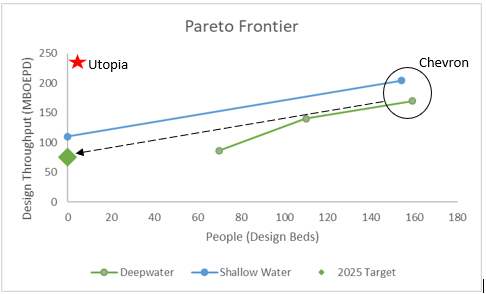 Note, projects not labeled Chevron are industry competitors.
7https://www2.deloitte.com/content/dam/Deloitte/us/Documents/process-and-operations/us-cons-predictive-maintenance.pdf
Note, projects not labeled Chevron are industry competitors.
7https://www2.deloitte.com/content/dam/Deloitte/us/Documents/process-and-operations/us-cons-predictive-maintenance.pdf
Mapping out our key implementation projects, development of the Digital Asset Lifecycle Management Platform (operational backbone) is the baseline project for deployment. Current state is this is handled at a project-specific level, for which requirements are provided from the Business Unit of operation. The shift to a Company-wide list of requirements is a precursor that is listed as third-party owned. From this perspective, we will rely on third-party experts to aid in development and deployment of the requirements to ensure full integration for all applications. The central control centers currently in operation are solely for monitor and optimization projects, typically without real-time data. The operational backbone will provide real-time information allowing full remote-control of facilities, including both operational and maintenance control. Use of robotics in the form of drone surveillance is current practice and will continue to expand. Building from the remote control centers, robotics control is aimed for deployment in 2025 via third-party. Note, we do not recommend the advanced remote sensing noted earlier as the value to reliability and NPV is small. Finally, looking beyond solely remote operation of processing facilities, multi-discipline integration of real-time data from the reservoir to product is the map for success.
Key Publications, Presentations and Patents
Technology Strategy Statement
Our target is to develop a remote operated offshore oil and gas platform in the Gulf of Mexico to be sanctioned (start detailed engineering) by 2025. Currently these large developments have ~100-150 people living on the platform. To reduce the safety risk, operational expense, and capital infrastructure to support people living on the platform we are pursuing a series of technology projects. As incremental goals, we will implement a series of project aimed at improving both automation and reliability. These two aspects are critical to economically remove people from offshore facilities. First, improving the digital infrastructure is critical as a primary investment to enable the reliability projects. Next, implementation of the Central Control Center will allow for improved data and predictive maintenance to improve reliability. Finally, robotic intervention will reduce mean-time-to-repair to decrease the downtime associated with an unplanned event. Advanced remote sensing was not included in the selected projects as the reliability and NPV value are estimated to be negligible compared to the overall project. Noting the financials, the projects through the Central Control Center are critical to achieving the goal of remote operation economically. The additional projects have higher risk and lower value and should be further assess for value. They are not critical at this time.
